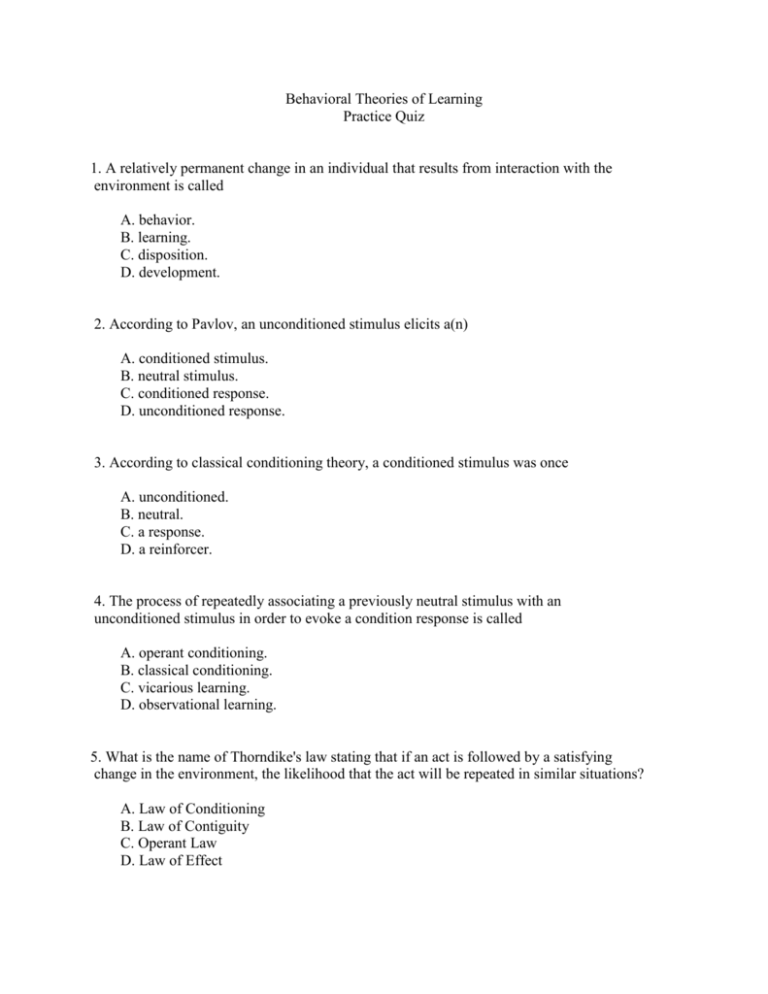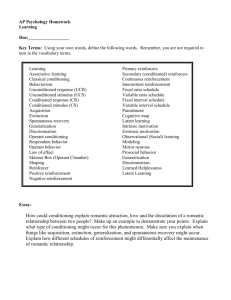Behavioral Learning Theories Quiz: Practice & Review
advertisement

Behavioral Theories of Learning Practice Quiz 1. A relatively permanent change in an individual that results from interaction with the environment is called A. behavior. B. learning. C. disposition. D. development. 2. According to Pavlov, an unconditioned stimulus elicits a(n) A. conditioned stimulus. B. neutral stimulus. C. conditioned response. D. unconditioned response. 3. According to classical conditioning theory, a conditioned stimulus was once A. unconditioned. B. neutral. C. a response. D. a reinforcer. 4. The process of repeatedly associating a previously neutral stimulus with an unconditioned stimulus in order to evoke a condition response is called A. operant conditioning. B. classical conditioning. C. vicarious learning. D. observational learning. 5. What is the name of Thorndike's law stating that if an act is followed by a satisfying change in the environment, the likelihood that the act will be repeated in similar situations? A. Law of Conditioning B. Law of Contiguity C. Operant Law D. Law of Effect 6. What term is used to describe the use of pleasant or unpleasant consequences to control the occurrence of behavior? A. operant conditioning B. classical conditioning C. extrinsic conditioning D. positive conditioning 7. Which of the following terms refers to the pleasurable consequence that maintains or increases a behavior? A. principle B. outcome C. reinforcer D. punisher 8. What type of reinforcer maintains or increases a targeted behavior by adding something desirable as a consequence? A. positive B. negative C. primary D. secondary 9. What type of reinforcer is a release from an unpleasant situation, which is given to strengthen or increase a targeted behavior? A. positive B. negative C. primary D. secondary 10. What rule states that enjoyable activities can be used to reinforce participation in less-enjoyable activities? A. Law of Effect B. Principle of Least Intervention C. Premack Principle D. Principle of Proximity 11. Praise or rewards given to motivate people to engage in behavior they might not want to engage in otherwise are called A. primary reinforcers. B. intrinsic reinforcers. C. extrinsic reinforcers. D. secondary reinforcers. 12. What term is used to describe the unpleasant consequences used to weaken or decrease a targeted behavior? A. shaping B. conditioning C. reinforcement D. punishment 13. The procedure of removing a student from a situation in which misbehavior was being reinforced is called A. time out. B. presentation punishment. C. negative reinforcement. D. immediacy of consequences. 14. What term is used to describe the teaching of a new skill or behavior by means of reinforcement for small steps toward the desired goal? A. extinction B. shaping C. maintenance D. discrimination 15. Which of the following reinforcement schedules involves giving a reward after a fixed number of behaviors? A. fixed-ratio B. variable-ratio C. fixed-interval D. variable-interval 16. Which of the following examples demonstrates a variable-interval schedule? A. Getting a free book after buying ten. B. Playing a slot machine. C. Having a test every Friday. D. Having some daily assignments graded, but not all. 17. What term is used to describe the use of cues, signals, or information to know when a behavior is to be reinforced? A. antecedent B. discrimination C. generalization D. modeling 18. The carryover of behaviors, skills, or concepts from one setting or task to another is called A. antecedent B. discrimination C. generalization D. modeling 19. What term is used to describe the type of learning that is based on observations of the consequences of others' behavior? A. vicarious B. regulated C. generalized D. antecedent 20. Meichenbaum’s self-regulated learning strategy is most similar to learning strategies proposed by A. Pavlov B. Piaget C. Skinner D. Vygotsky











